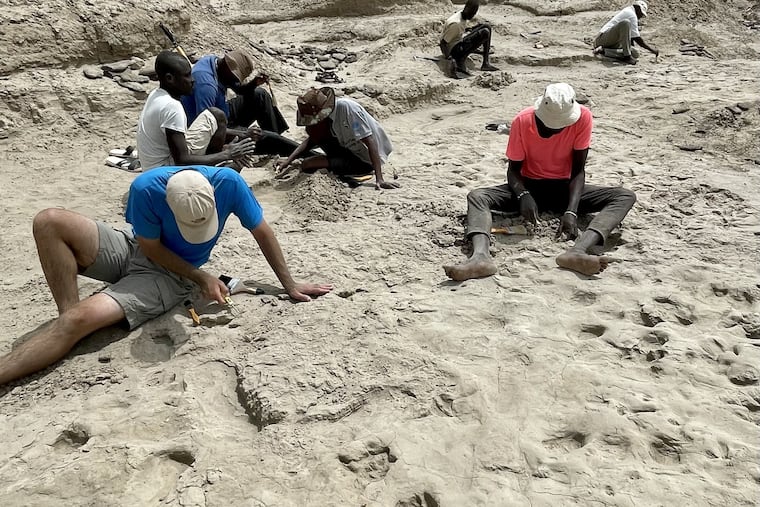Ancient footprints show two different human ancestors coexisted at the same spot 1.5M years ago
The research included professors Kevin Hatala from Chatham U. in Pittsburgh and Craig Feibel of Rutgers and showed two human species might have competed or cooperated.

Maybe they helped each other. Maybe they ran from each other. Maybe they ignored each other.
It’s long been known that multiple species of ancient humans lived in the same hot, lush lakeshore area of East Africa. Yet skeletal remains have made that difficult to prove.
Now, a team of researchers say they have unearthed 1.5 million-year-old footprints from two sets of hominins, or extinct human ancestors, that show the species were present at the same time at Koobi Fora around the shore of Lake Turkana in Kenya. The discovery was published on Thursday in Science. The team included Kevin Hatala, the study’s first author and an associate professor of biology at Chatham University in Pittsburgh, and Craig Feibel, a geology professor at Rutgers University.
The paper’s authors say the footprints offer solid evidence that different hominin species overlapped as they might have run from predators, sought food, or possibly even cooperated or competed.
“This is the first time that two different species of hominins have been recognized from footprints in the same surface,” said Feibel, who has studied fossils in Kenya since the 1980s. “It’s an exciting demonstration of using footprints as evidence.”
The research is a result of a project run by paleontologist Louise Leakey. Her grandparents, famed paleoanthropologists Louis and Mary Leakey, made the family renowned for finds at Olduvai Gorge in Tanzania. Louise Leakey’s parents, Richard and Meave, continued the tradition and performed notable research at the Turkana Basin. Kenyans working for Louise Leakey made the discovery.
Early humans
Using advanced dating techniques, the paper’s authors placed the footprints of Homo erectus and Paranthropus boisei together during the Pleistocene, suggesting some level of coexistence. The Pleistocene Epoch lasted from 2.5 million years ago to 11,000 years ago and includes the ice age.
Both Homo erectus and Paranthropus boisei are hominins, a relatively new term in anthropology that refers to subdivisions of the larger category known as hominids. All species of hominins, extinct or alive, are considered to be within the human lineage that emerged after splitting from ancestors of great apes about 6 million to 7 million years ago. Homo sapiens — modern human beings — are the only hominins that now exist.
The footprints suggest two completely different species of hominins may have scavenged for food at the same time on a savannah with bountiful wildlife.
Neanderthals also lived with modern humans for thousands of years, but that was in Europe and much more recently. The two species interbred outside of Africa, proven by traces of Neanderthal DNA found in modern humans. Neanderthals disappeared by about 40,000 years ago.
But the footprints discovery released this week in Science, a peer-reviewed academic journal of the American Association for the Advancement of Science, sets the timeline far earlier for hominin coexistence.
The problem with bones
Feibel said bones have been found at various sites suggesting different species of humans have coexisted. However, he said, bones can be moved by floods, animals, and even people. So finding sets of bones near each other is not necessarily an indication different types of humans lived together. And it’s difficult to place the bones at the same location at the same time.
“You might find one species that commonly occurs alongside the bones of, say, a warthog or something like that. That tells you it’s out in the open grasslands. But it always run back to this problem of the bones are not necessarily where the animals live, and so it isn’t, in essence, proof. But with the footprints, there’s no question that they were both there in that spot at the edge of the lake.”
In this case, Feibel explained, a Kenyan crew working for Leakey was in search of fossils when they came across a footprint buried under soil. They carefully began removing the layer of soil, only to find more and more footprints, all at the same level. That depth told researchers that the footprints occurred at, or very near, the same time.
The proof is in the footprint
The footprints allowed Hatala, the Chatham University professor, to use new analytical techniques to establish different walking patterns, gaits, and foot anatomy. The separate patterns were seen on the same surfaces and across multiple locations. The scientists said that this analysis presented direct evidence that the two different hominins repeatedly crossed paths, possibly within hours or days along the sandy, silty trails.
Scientists looked at how walking is shaped by the motion of feet, such as heel-sole-toe rollover. Humans have a relatively high arch and follow a distinctive pattern and depth. The team was able to determine that two different species that were different from modern humans or chimpanzees.
The team preserved five likely track surfaces where the ancient humans walked. Bones were also found nearby. The hominins used the same paths as birds that left tracks as big as 11 inches wide. It’s known giant Leptoptilos storks as big as a human once inhabited the area.
Authors wrote that the isolated tracks and those of other mammals and birds on the surface were “geologically instantaneous” and that “it is clear that hominins were repeatedly visiting lake margin habitats, walking on wet substrates, wading into shallow water, and potentially interacting with other animals frequenting these environments.”
Feibel said the new way to analyze footprints can be used by other scientists.
“Now we know that we can discriminate between different species on the basis of footprints at other sites,” Feibel said. “So it has expanded our understanding of what we can learn.”